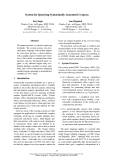
Natural language systems
-
Lecture “Natural language processing – Chapter 5: Foundation of statistical machine translation” has contents: Introduction to statistical machine translation, statistical MT systems, three problems in statistical MT systems, translation model, and other contents.
 12p
12p  dien_vi01
dien_vi01
 21-11-2018
21-11-2018
 21
21
 0
0
 Download
Download
-
The nature and amount of information needed for learning a natural language, and the underlying mechanisms involved in this process, are the subject of much debate: is it possible to learn a language from usage data only, or some sort of innate knowledge and/or bias is needed to boost the process? This is a topic of interest to (psycho)linguists who study human language acquisition, as well as computational linguists who develop the knowledge sources necessary for largescale natural language processing systems. ...
 1p
1p  hongphan_1
hongphan_1
 15-04-2013
15-04-2013
 66
66
 2
2
 Download
Download
-
This paper presents a system for querying treebanks. The system consists of a powerful query language with natural support for cross-layer queries, a client interface with a graphical query builder and visualizer of the results, a command-line client interface, and two substitutable query engines: a very efficient engine using a relational database (suitable for large static data), and a slower, but paralel-computing enabled, engine operating on treebank files (suitable for “live” data). ...
 4p
4p  hongphan_1
hongphan_1
 15-04-2013
15-04-2013
 44
44
 4
4
 Download
Download
-
ProLiV - Animated Process-modeler of Complex (Computational) Linguistic Methods and Theories - is a fully modular, flexible, XML-based stand-alone Java application, used for computer-assisted learning in Natural Language Processing (NLP) or Computational Linguistics (CL).
 4p
4p  hongphan_1
hongphan_1
 15-04-2013
15-04-2013
 60
60
 4
4
 Download
Download
-
We demonstrate an information credibility analysis system called WISDOM. The purpose of WISDOM is to evaluate the credibility of information available on the Web from multiple viewpoints. WISDOM considers the following to be the source of information credibility: information contents, information senders, and information appearances. We aim at analyzing and organizing these measures on the basis of semantics-oriented natural language processing (NLP) techniques.
 4p
4p  hongphan_1
hongphan_1
 15-04-2013
15-04-2013
 42
42
 3
3
 Download
Download
CHỦ ĐỀ BẠN MUỐN TÌM


















